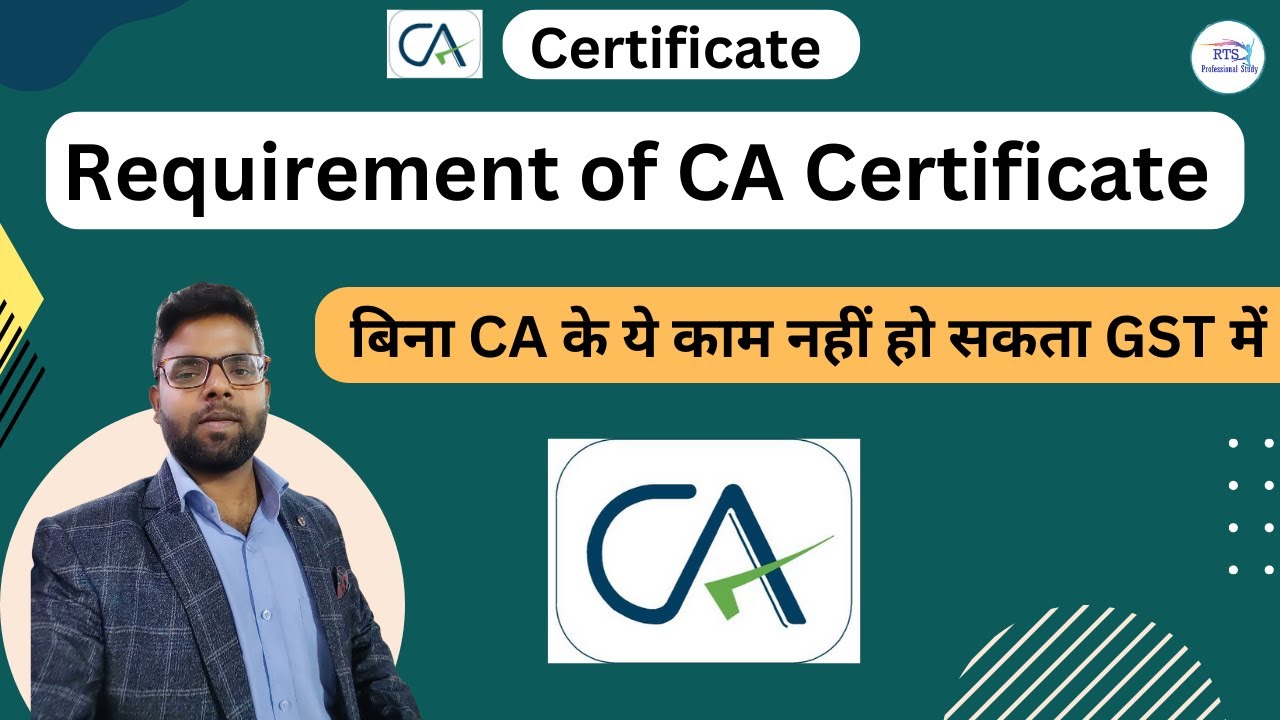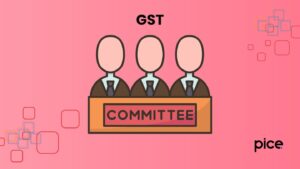How to obtain a CA Certificate for a GST Refund?
- 21 Aug 24
- 23 mins

How to obtain a CA Certificate for a GST Refund?
- Certificate under Section 18(1)(c) of the CGST Act
- Certificate under Section 18(1)(d) of the CGST Act
- Certificate under Section 18(3) of the CGST Act
- Certificate under Section 54 of the CGST Act
- Certificate under Section 29(5) of the CGST Act
- Certificate under Section 18(4) of the CGST Act: Composite Tax Payer
- Certificate under Section 18(4) of the CGST Act-Taxable supplies by registered person become wholly exempt
- Steps to submit a refund claim application form
- Refund process of IGST paid on export of goods (with tax payment)
- Steps to apply in form RFD-01 for different types of GST refund
- GST refund process for embassies and international organisations
- What happens after the GST refund is applied?
- Tax in Respect of Input Services and Refund Scenarios
Key Takeaways
- Accurate Documentation: Ensuring detailed and accurate documentation is crucial for successful GST refund claims.
- Timely Application: Submit refund applications promptly to avoid delays and ensure compliance with prescribed time limits.
- Expert Assistance: Utilize the expertise of chartered accountants to verify and certify refund claims, enhancing credibility and compliance.
- Electronic Credit Ledger: Monitor and manage the electronic credit ledger effectively to track input tax credits and refund statuses.
- Communication with Authorities: Maintain clear and prompt communication with GST authorities to resolve queries and expedite the refund process.
The Central Goods and Services Tax (CGST) Act is a crucial part of the Indian taxation system. Various certificates under different sections of this Act play significant roles in ensuring compliance, availing benefits, and processing refunds. This article explores the different certificates under the CGST Act, their purposes, and the processes involved in obtaining them.

Certificate under Section 18(1)(a) of the CGST Act
The certificate under Section 18(1)(a) of the CGST Act is crucial for businesses that become liable to pay tax under the GST regime. This certificate allows such businesses to claim input tax credit (ITC) on stock held on the day immediately preceding their liability date.
By enabling the claiming of ITC, this certificate helps reduce the overall tax burden on newly registered taxpayers, ensuring a smoother financial transition into the GST system. It is essential for businesses to maintain accurate stock records and submit the necessary documentation to obtain this certificate and benefit from its provisions.
Certificate under Section 18(1)(c) of the CGST Act
The certificate under Section 18(1)(c) of the CGST Act is essential for businesses that cease to pay tax under the composition scheme upon reaching the turnover threshold of ₹1.5 crores (₹75 lakhs for special category states). This certificate allows these businesses to claim input tax credit (ITC) on the stock and inputs held on the day immediately preceding the date when they opt out of the composition scheme.
This transition helps businesses adjust to the regular tax regime, ensuring they can continue to operate smoothly without facing a sudden tax burden. Accurate documentation and timely application are critical to availing of the benefits of this certificate.
Certificate under Section 18(1)(d) of the CGST Act
The certificate under Section 18(1)(d) of the CGST Act is issued when an exempt supply of service or goods becomes taxable. This certificate enables businesses to claim input tax credit (ITC) on the stock and inputs held on the day immediately preceding the date from which the supply becomes taxable.
This provision is vital for businesses transitioning from an exempt status to a taxable status, as it helps mitigate the financial impact of the new tax liabilities. Maintaining accurate records of stock and inputs and ensuring timely application for this certificate are crucial for benefiting from ITC and maintaining smooth operations during this transition.
Certificate under Section 18(3) of the CGST Act
The certificate under Section 18(3) of the CGST Act is essential for businesses undergoing a transfer, whether through sale, merger, or another form of business reorganization. This provision allows for the transfer of unutilized input tax credits (ITC) from the old entity to the new entity, ensuring that the new business can continue operations without losing tax credits.
For example, if Company A is sold to Company B, the unutilized ITC of Company A can be transferred to Company B. This certificate ensures a seamless transition and continuity in tax benefits, which is crucial for maintaining the financial health of the business during structural changes. Accurate documentation and timely application are critical to benefiting from this provision, ensuring compliance and operational smoothness during the transfer.
Certificate under Section 54 of the CGST Act
The certificate under Section 54 of the CGST Act is a key document for businesses seeking a refund of taxes paid under various circumstances. This section covers refunds for excess tax payments, tax paid on zero-rated supply exports, tax paid on inputs used in the production of export goods, and tax paid on supplies to SEZ units or developers. Refunds for taxes paid by embassies and international organizations are also subject to it.
To claim a refund under Section 54, businesses must submit an application through the GST common portal, providing necessary documentation such as invoices, shipping bill details (for exports), and proof of tax payment. The GST authorities then review the application to confirm the information and approve the refund.
This certificate is crucial as it ensures that businesses can reclaim taxes paid in excess, thereby improving cash flow and maintaining financial health. Proper documentation and adherence to the prescribed procedure are essential for a successful refund claim.
Certificate under Section 29(5) of the CGST Act
The certificate under Section 29(5) of the CGST Act is issued when a registered person’s GST registration is canceled, either voluntarily or by the tax authorities. This certificate is crucial for finalizing tax liabilities and settling any outstanding dues before the cancellation becomes effective.
For businesses winding up operations or ceasing to exist under the GST regime, this certificate ensures that all tax obligations are cleared, preventing future legal or financial complications.
To obtain this certificate, businesses must apply through the GST portal, providing necessary details about their tax liabilities, stock, and any unutilized input tax credit. Before issuing the certificate, the GST authorities review the application and confirm the accuracy of the data provided.
This process ensures that the business has met all its tax obligations, facilitating a smooth closure of its GST account. Proper documentation and timely submission are essential for avoiding delays and ensuring business compliance with the GST regulations.
Certificate under Section 18(4) of the CGST Act: Composite Tax Payer
The certificate under Section 18(4) of the CGST Act is essential for composite taxpayers who opt to pay tax at a fixed rate on their turnover instead of the regular GST rates. When a composite taxpayer switches to a regular GST scheme or their supplies become wholly exempt, they need to claim the input tax credit (ITC) on the stock and inputs held on the day immediately preceding the date of such transition or exemption.
To obtain this certificate, a composite taxpayer must provide detailed records of their stock and inputs. This ensures they can claim the ITC they are entitled to upon transitioning to the regular tax regime or when their supplies become exempt.
The application for this certificate must be submitted through the GST portal, where the authorities will verify the details provided. This certificate is crucial for ensuring that the taxpayer can utilize their ITC and maintain seamless operations during the transition from the composition scheme. Proper documentation and timely application are key to benefiting from this provision.
Certificate under Section 18(4) of the CGST Act-Taxable supplies by registered person become wholly exempt

The certificate under Section 18(4) of the CGST Act is issued when a registered person’s taxable supplies become wholly exempt. This certificate is crucial for allowing the taxpayer to claim input tax credit (ITC) on the stock and inputs held on the day immediately preceding the date when the supplies become exempt.
This provision ensures that businesses can recover the taxes already paid on inputs, preventing financial losses due to the change in tax status.
To obtain this certificate, businesses must provide accurate records of their stock and inputs. The application, submitted through the GST portal, will be reviewed by the authorities to verify the details before issuing the certificate.
This process helps maintain financial stability for businesses undergoing such transitions by enabling them to reclaim ITC and adjust to the new tax-exempt status without incurring additional costs. Proper documentation and timely application are essential to benefiting from this provision.
Need for CA Certificate
A Chartered Accountant (CA) certificate is often required for various GST-related processes, especially when claiming significant refunds. The involvement of a CA helps ensure that the financial details provided are accurate, complete, and compliant with GST regulations. Here’s why a CA certificate is essential:
- Accuracy of Financial Details
A CA meticulously reviews the financial records and ensures that all details in the refund claim or other applications are accurate. This reduces the chances of errors and discrepancies that could lead to delays or rejections.
- Compliance with GST Regulations
CAs are well-versed in GST laws and regulations. Their expertise ensures that the application complies with all legal requirements, preventing potential legal issues or penalties.
- Verification of Documents
The CA certifies that all supporting documents, such as invoices, tax payment receipts, and financial statements, are genuine and correctly reflect the business transactions. This verification adds credibility to the application.
- Prevention of Fraudulent Claims
The involvement of a CA helps prevent fraudulent claims by ensuring that only legitimate transactions and tax payments are included in the refund claim. This safeguards the integrity of the GST system.
- Expert Advice and Guidance
CAs provide valuable advice and guidance on various GST-related matters. Their expertise can help businesses optimize their tax liabilities, claim eligible refunds, and maintain overall secretarial compliance.
- Audit Trail and Transparency
A CA-certified application provides an audit trail, making it easier for GST authorities to verify and process the claim. This transparency builds trust and facilitates a smoother refund process.
- Handling Complex Cases
For businesses with complex transactions or high-value refunds, the expertise of a CA is crucial. They can navigate the intricacies of GST regulations and ensure that the application is thorough and robust.
- Reducing Processing Time
Applications certified by a CA are likely to be processed faster, as the authorities have confidence in the accuracy and compliance of the information provided. This can lead to quicker refund approvals and disbursements.
- Ensuring Proper Record-Keeping
CAs ensure that businesses maintain proper records of all transactions, supporting documents, and correspondence related to the GST application. This is essential for future audits and resolving any queries from the authorities.
- Facilitating Communication with Authorities
CAs often act as intermediaries between the business and GST authorities, facilitating effective communication and resolution of any issues that arise during the application process.
Steps to submit a refund claim application form

Submitting a refund pre-application form is a crucial step in the GST refund process. This step ensures that all necessary information and documentation are in place before the actual application for refund is filed.
Here are the steps to successfully submit a refund pre-application form:
- Log in to the GST Portal
Access the GST portal using your credentials (username and password).
Navigate to the 'Services' tab.
- Navigate to Refunds
Under the 'Services' tab, select 'Refunds'.
Choose 'Application for Refund' from the drop-down menu.
- Select Pre-Application Form
In the refund application section, select the 'Pre-Application Form' option.
This form is a prerequisite for the actual refund application.
- Fill in the Required Details
Provide all necessary details, including:
GSTIN (GST Identification Number)
Legal name of the business
Trade name (if applicable)
Contact information (address, email, phone number)
- Specify the Refund Type
Indicate the type of refund you are applying for (e.g., excess tax payment, export of goods/services, deemed exports).
Ensure you choose the correct refund type to avoid processing delays.
- Upload Supporting Documents
Attach all relevant documents required for the pre-application, such as:
Invoices
Shipping bills(for export refunds)
Tax payment proofs
Bank account details for the refund
- Review and Validate Information
Carefully review all the information and documents provided to ensure accuracy.
Validate the details to avoid any discrepancies that could lead to delays or rejections.
- Submit the Pre-Application Form
Once all details are verified, submit the pre-application form.
You will receive an acknowledgment receipt with a reference number.
- Track the Application Status
Use the reference number to track the status of your pre-application form on the GST portal.
If GST authorities contact you, respond to them right away with any questions or concerns.
- Prepare for Final Application
Once the pre-application is accepted, gather any additional information or documents required for the final refund application.
Follow the instructions provided by the authorities for the next steps in the refund process.
Refund process of IGST paid on export of goods (with tax payment)
Claiming a refund for Integrated Goods and Services Tax (IGST) paid on exported goods is a vital process for exporters, ensuring that they do not face a financial burden due to the taxes paid on exports. Here is a step-by-step guide to the refund process:
- Ensure Eligibility
Ensure that the goods are exported with payment of IGST and that the export is classified as a zero-rated supply under GST law.
- File Shipping Bill
File the shipping bill electronically with the customs authorities. The shipping bill is a key document in the export process and serves as a refund application for IGST.
Ensure that the shipping bill contains all necessary details, including the GSTIN, invoice number, and IGST amount paid.
- File GSTR-1
Report the export invoice details in Table 6A of the GSTR-1 form (Outward Supplies).
Ensure that the invoice details in GSTR-1 match those in the shipping bill.
- File GSTR-3B
File the GSTR-3B return for the relevant tax period, reporting the total IGST paid on the exported goods.
Ensure that the tax paid in GSTR-3B matches the IGST amount mentioned in the shipping bill and GSTR-1.
- Automatic Refund Processing
Once both the shipping bill and GSTR-3B are filed, the customs system and GST portal will cross-verify the details.
The refund process is generally automated, provided there are no discrepancies between the shipping bill and GSTR returns.
- Track Refund Status
Track the status of your refund application on the ICEGATE portal (Indian Customs Electronic Gateway) and the GST portal.
Use the reference numbers provided during the submission of your shipping bill and GSTR returns to monitor the progress.
- Address Discrepancies
If there are any discrepancies or mismatches in the submitted documents, you may receive a query from the authorities.
Address these discrepancies promptly by providing the required clarifications or additional documents.
- Receive Refund
Once the verification is complete and no discrepancies are found, the refund will be processed.
The refund amount will be credited to your bank account registered with the GST portal.
- Maintain Records
Keep all records of the shipping bill, GSTR-1, GSTR-3B, and any correspondence with authorities for future reference.
Proper documentation is crucial for audit purposes and to address any future queries from the authorities.
- Reconcile Refunds
Regularly reconcile your refunds with your accounting records to ensure that all claimed refunds have been received.
Report any issues or delays to the GST helpline or customs authorities to seek resolution.
Steps to apply in form RFD-01 for different types of GST refund
Applying for a GST refund using Form RFD-01 is a crucial process for businesses seeking to reclaim excess taxes paid, export refunds, or other types of GST-related refunds. Here's a step-by-step guide to help you navigate this process:
- Log in to the GST Portal
Access the GST portal using your login credentials (username and password).
Navigate to the ‘Services’ tab.
- Navigate to Refunds
Under the ‘Services’ tab, select ‘Refunds’.
Click on ‘Application for Refund’ to proceed.
- Select Refund Type
Choose the type of refund you are applying for from the list of available options. This may include:
Excess balance in the electronic cas ledger
Export of goods/services with payment of tax (IGST)
Export of goods/services without payment of tax (LUT/Bond)
Supply of goods/services to SEZ units/developers
Deemed exports
Inverted duty structure (where the tax rate on inputs is higher than on outputs)
Refund on account of assessment/provisional assessment/appeal/any other order
Refund of excess payment of tax
Refund on account of issuance of refund vouchers for taxes paid on advances against which goods or services have not been supplied
- Fill in the Details
Complete the relevant sections of Form RFD-01, including:
Tax period for which the refund is claimed
Amount of refund claimed
Details of the tax paid and supporting documents (e.g., invoices, shipping bills for exports)
- Upload Supporting Documents
Attach all necessary supporting documents, such as:
Export invoices and shipping bills (for export refunds)
Bank Reconciliation certificates
Copies of LUT/Bond (if applicable)
Tax payment proofs and invoices
Any other relevant documents supporting the refund claim
- Preview the Form
Review the completed Form RFD-01 to ensure all details are accurate and all required documents are attached.
Make any necessary corrections before submission.
- Submit the Application
Submit Form RFD-01 through the GST portal.
You will receive an acknowledgment receipt with an ARN (Application Reference Number).
- Track the Application Status
Use the ARN to track the status of your refund application on the GST portal.
Regularly check for updates and respond promptly to any queries from GST authorities.
- Respond to Queries
If the GST authorities raise any queries or require additional information, provide the necessary details promptly.
This step is crucial to avoid delays in processing your refund application.
- Receive Refund
Once the application is verified and approved, the refund amount will be processed.
The refund will be credited to the bank account registered with your GST profile.
- Maintain Records
Keep copies of all submitted documents, acknowledgment receipts, and correspondence with the GST authorities for future reference.
Proper record-keeping is essential for audit purposes and to address any future queries from the authorities.
- Refund claim by unregistered person
Unregistered persons, who are not registered under the GST regime, can still claim a refund in certain scenarios. This typically applies when an unregistered individual has paid GST on goods or services but later becomes eligible for a refund. Here’s how unregistered persons can claim a GST refund:
- Eligibility
Unregistered persons can claim refunds in cases such as:
Cancellation of a contract where GST was paid in advance.
Return of goods or services where GST was paid and the transaction did not materialize.
Any other scenario where GST was paid but later deemed refundable.
- Gather Required Documents
Collect all necessary documentation, including:
Proof of GST payment (tax invoices, receipts).
Details of the goods or services purchased.
Proof of cancellation or return of goods/services.
Identity proof and address proof.
Bank account details for receiving the refund.
- Prepare the Refund Application
Unregistered persons must manually fill out the refund application in Form RFD-01A.
Include all relevant details, such as:
Amount of refund claimed.
Reason for the refund.
Supporting documents.
- Submit the Application to Jurisdictional GST Office
Submit the completed Form RFD-01A along with supporting documents to the jurisdictional GST office.
Ensure that all details are accurate and the application is complete to avoid delays.
- Verification by GST Authorities
The GST authorities will review the refund application and the supporting documents.
They may contact the applicant for any additional information or clarification required.
- Track the Application Status
Maintain communication with the jurisdictional GST office to track the status of your refund application.
Be prompt in responding to any queries or additional document requests from the authorities.
- Receive the Refund
Once the refund application is verified and approved, the refund amount will be processed.
The refund will be credited to the bank account provided in the application.
- Maintain Records
Keep copies of the refund application, acknowledgment receipts, and any correspondence with the GST authorities.
Proper documentation is essential for audit purposes and to address any future queries regarding the refund.
GST refund process for embassies and international organisations
Here’s a step-by-step guide to the GST refund process for embassies and international organizations:

Embassies and international organizations are eligible for GST refunds on goods and services procured in India. The refund process for these entities is designed to ensure that they are not burdened with GST, in line with international diplomatic norms.
- Eligibility
Embassies, consulates, and international organizations are eligible for GST refunds on goods and services purchased in India, provided they follow the prescribed procedures.
- Gather Required Documents
Ensure you have all the necessary documentation, including:
Invoices showing the GST paid on purchases.
Proof of payment for the goods or services.
Authorization letter from the embassy or international organization authorizing the refund application.
- Prepare the Refund Application
The refund application must be prepared in Form RFD-10, specifically designed for embassies and international organizations.
Include all relevant details, such as the amount of GST paid, the purpose of the purchase, and the supporting invoices.
- Submit the Application to Jurisdictional GST Office
Submit the completed Form RFD-10 along with all supporting documents to the jurisdictional GST office.
Ensure that all details are accurate and the application is complete to avoid delays.
- Verification by GST Authorities
The GST authorities will review the refund application and the supporting documents.
They may contact the embassy or international organization for any additional information or clarification required.
- Track the Application Status
Maintain communication with the jurisdictional GST office to track the status of your refund application.
Be prompt in responding to any queries or additional document requests from the authorities.
- Receive the Refund
Once the refund application is verified and approved, the refund amount will be processed.
The refund will be credited to the bank account provided in the application.
- Maintain Records
Keep copies of the refund application, acknowledgment receipts, and any correspondence with the GST authorities.
Proper documentation is essential for audit purposes and to address any future queries regarding the refund.
- Key Points to Remember
Timely Submission: Ensure that the refund application is submitted within the prescribed time limits to avoid rejections or delays.
Accurate Documentation: Accurate and complete documentation is crucial for the successful processing of the refund application.
Regular Follow-ups: Regular follow-ups with the GST office can help expedite the refund process and address any issues promptly.
What happens after the GST refund is applied?
Once a GST refund application is submitted, several steps follow to ensure that the claim is processed efficiently and accurately. Understanding these steps can help applicants track their refund status and address any issues that arise. Here’s a detailed look at what happens after the GST refund is applied:
- Acknowledgment Receipt
Upon submission of the GST refund application, the applicant receives an acknowledgment receipt with an ARN (Application Reference Number). This ARN is crucial for tracking the status of the refund application.
- Initial Verification
The GST portal performs an initial verification of the application. This includes checking the completeness of the application and ensuring that all required documents are submitted.
- Processing by Jurisdictional Officer
The application is forwarded to the jurisdictional GST officer for further scrutiny. The officer reviews the details of the refund claim, including invoices, shipping bills (for exports), and other supporting documents.
- Provisional Refund (If Applicable)
In certain cases, a provisional refund of 90% of the claim amount may be granted to the applicant within seven days of acknowledgment. This is typically applicable for zero-rated supplies and is subject to specific conditions.
- Detailed Scrutiny
The jurisdictional officer conducts a detailed scrutiny of the refund application. This involves verifying the accuracy of the claimed amounts, cross-checking the submitted documents, and ensuring direct tax compliance with GST regulations.
- Communication with Applicant
If there are any discrepancies or additional information required, the GST officer communicates with the applicant. The applicant must respond promptly to any queries or requests for additional documentation to avoid delays.
- Order Issuance
Once the scrutiny is complete, the GST officer issues an order either approving or rejecting the refund claim. The order is communicated to the applicant through the GST portal.
- Credit to Bank Account
If the refund claim is approved, the refund amount is credited to the applicant’s bank account registered with the GST portal. This typically happens within 60 days from the date of receipt of the application.
- Adjustment Against Liabilities
In some cases, the approved refund amount may be adjusted against any outstanding tax liabilities of the applicant. This adjustment is communicated in the refund order.
- Tracking the Refund Status
Applicants can track the status of their refund application using the ARN on the GST portal. Regularly monitoring the status helps in staying updated on the progress and addressing any issues promptly.
- Post-Refund Compliance
After receiving the refund, it is important to maintain proper records of the refund application, acknowledgment receipt, refund order, and any correspondence with the GST authorities. These records are essential for audit purposes and to resolve any future queries.
Tax in Respect of Input Services and Refund Scenarios
The GST framework offers various provisions for claiming refunds in respect of tax paid on input services. Businesses can claim refunds for unutilized input tax credit (ITC) in several scenarios, ensuring efficient cash flow management and compliance with tax regulations.
Refund scenarios include excess tax paid, exports of goods and services, and supplies to SEZ units. Refunds are processed through the electronic credit ledger, where businesses can track the credit of input tax and its utilization.
The authenticity of the credit claimed is crucial, requiring accurate documentation and verification by GST authorities. In case of erroneous credit claims, businesses must reverse the credit to maintain compliance. Credit notes and remittance certificates play a vital role in the refund process, substantiating the claims made by businesses.
For interstate supply of services, the tax paid can also be claimed as a refund, provided the necessary conditions are met. Businesses must submit the prescribed certificate and ensure that all documents are in order. Proper application for supplies and accurate issuance of certificates are essential for a smooth refund process.
Conclusion
The GST refund process requires meticulous attention to detail, timely submissions, and adherence to regulations. By maintaining accurate documentation, leveraging the expertise of Chartered Accountants, and effectively managing the electronic credit ledger, businesses can streamline their refund claims and ensure compliance.
Clear communication with GST authorities further facilitates a smooth and efficient refund process, ultimately enhancing financial management and operational efficiency.
💡Facing delays in GST payment? Get started with PICE today and streamline your GST payments. Click here to sign up and take the first step towards hassle-free GST management.




















